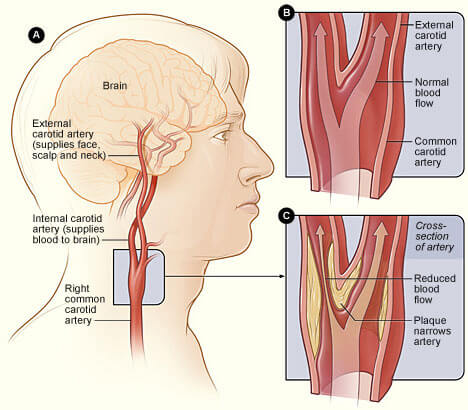The carotid arteries are the major arteries in the neck that supply blood to the brain. Carotid artery disease occurs when these arteries become narrowed or blocked due to plaque buildup on the artery walls. This causes a reduction or disruption in blood flow to your brain and can cause a stroke.
The risk of carotid artery disease increases with age.
It most commonly occurs in people over the age of 80. People with diabetes and a family history of hardening of the arteries may have increased risk of developing this disease.  Plaque buildup in the arteries can also lead to carotid
artery disease. Buildup can be caused by injury to the artery walls from high cholesterol or high blood. Heart-healthy behaviors such as abstaining from tobacco usage, exercising regularly, eating a healthy diet, and maintaining a healthy weight,
can help prevent carotid artery disease.
Plaque buildup in the arteries can also lead to carotid
artery disease. Buildup can be caused by injury to the artery walls from high cholesterol or high blood. Heart-healthy behaviors such as abstaining from tobacco usage, exercising regularly, eating a healthy diet, and maintaining a healthy weight,
can help prevent carotid artery disease.
Symptoms
Carotid artery disease may not cause symptoms in its early stages. The first sign of disease may be a stroke. However, warning symptoms of a stroke called transient ischemic attacks or TIAs can be experienced. These typically last for a few minutes to 1 hour and include:
- Feeling weakness, numbness or a tingling sensation on one side of the body
- Being unable to control movement of an arm or leg
- Losing vision in one eye
- Being unable to speak clearly
These symptoms usually go away within 24 hours but should not be ignored. Experiencing a TIA means there is a high risk for stroke and the symptoms should be reported to a physician immediately.
Diagnosis & Treatment Options
Diagnosis begins with a physical exam that includes questions about the patient’s medical history, measuring blood pressure, and listening for sounds of turbulent blood flow in the arteries. If carotid artery disease is suspect your physician may
order additional imaging tests, including: carotid ultrasound, CT scan, CT angiography, magnetic resonance angiography.
Treatment options are dependent on the severity of the condition, whether symptoms are present, and the patient’s
general health. Lifestyle changes or medication may be a first step to control risk factors such as diabetes, high blood pressure, high cholesterol and smoking. Severe cases or cases with signs of progression my require surgery. Our vascular surgeons
offer several surgical options.
Carotid endarterectomy surgery removes the plaque from the arteries through an incision in the neck and leaves behind a smooth, wide-open artery.
Angioplasty and stenting is
a minimally-invasive procedure usually performed with local anesthetic. The surgeon will make an incision in the groin, insert a catheter and guide it through the blood vessels to the carotid artery. Dye will be injected and an x-ray image will be
taken to show the location and details of the obstruction. The surgeon then inserts another catheter carrying a tiny balloon that is inflated and deflated, flattening the plaque against the walls. Finally, a tiny metal-mesh tube (stent) is placed
in the artery to hold it open.
Each treatment option has its own benefits and risks. Prevea vascular surgeons work with each patient to determine the best treatment option for their situation.